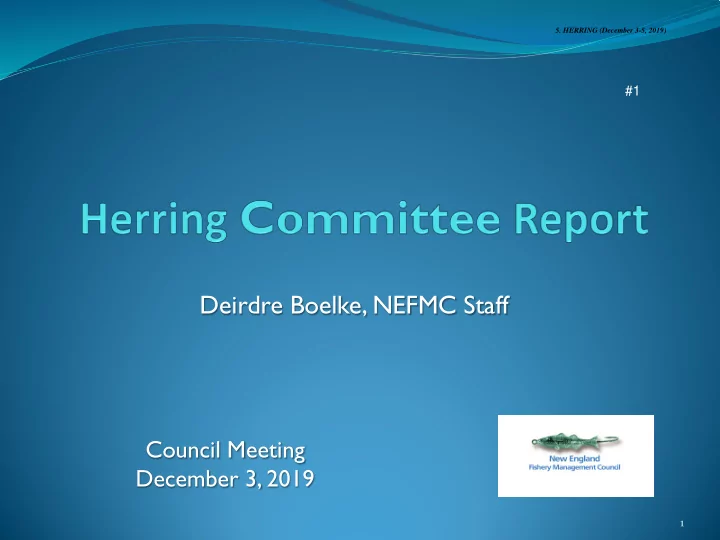

5. HERRING (December 3-5, 2019) #1 Deirdre Boelke, NEFMC Staff Council Meeting December 3, 2019 1
Outline of presentation Review final discussion document on spawning of Atlantic 1. herring on Georges Bank (Document #2). Review final Amendment 8 Management Strategy Evaluation 2. (MSE) Process Debrief (Document #3). Agenda today: Review Final Reports No Council Action Needed 2
GB Spawning Document (Doc. #2) Gulf of Maine Research Institute (GMRI) awarded contract in May 2019 – 6 month timeline. Scope: Review historical and current scientific research and other relevant information about offshore spawning of At. Herring. Summer/Fall - review and input from PDT, AP and Cmte. Final report delivered in November. 3
Outline of discussion document 1.0 Background - Review of herring biology, spawning and management, other examples (now complete) 2.0 Analysis of existing data sets – dockside program, federal trawl survey, larval tows, food habits database (fish stomachs), herring egg EFH, historical maps, interviews. 3.0 Building a consensus - model for inferring spawning areas Consideration of existing maps and datasets: 4.0 Herring Fishing Effort 5.0 Potential impacts on offshore spawning (now complete) 6.0 PDT research recommendations 4
1.0 Background Spawning info primarily from Amendment 8. Spawning closures as a management tool. History of spawning closures in the GOM. Current approach used in GOM. Examples of herring spawning protections in other areas of the world – not exhaustive. 5
5.0 Potential Impacts Potential fishery impacts – on spawner biomass, disturbance of benthic egg mats, potentially disrupting spawning activity. Potential areas of overlap with groundfish, sea scallop, surf clam/ocean quahog fisheries (Fig. 5.1.1 – 5.1.5) – annual maps only. Potential climate threats (multiple references cited) Somewhat buffered due to ability to shift distribution from warming waters – highly exposed but low sensitivity. Herring will likely shift northward. Strong natal homing for spawning – could delay or shift north with less favorable conditions for success. Calanus has decreased in eastern Maine – favored food source. Potential threats from predators Overall predation pressure seems constant varies by species/year, competition with other herring and mackerel, egg predation (focus on haddock). 6
Highlights from consensus analysis: • Multiple data sources were reviewed and analyzed and all pointed towards spawning in two locations along northern edge of GB; one in the west (Nantucket Shoals/Great South Channel) and one in the east (Northern Flank). • Spawning takes place primarily between September and October (all years and all areas). • Spring spawning is not important. • Industry interacts minimally with spawning grounds (mostly in the east). NEFMC initiated an action to address offshore spawning (Sept 2019). 7
8
Scope of Debrief 2019 priority; solicit feedback on MSE Process. Collect perceptions, pros/cons, lessons learned to help inform future Council decisions on use of MSE as a process. Phase Purpose Timeline Planning Develop purpose and goal, work April - June plan, Council approval Gathering Public comments, PDT input, July - Sept feedback AP/Cmte input, Council input Reporting Compile input, finalize report, Oct - Dec final report to Council Agenda Today – Review final report. 9
Amendment 8 MSE Process Was the purpose and need clear? 1. General education sufficient? 2. • Six phases of A8 MSE Utility of 6 phases of MSE process? 3. • Timing Use of open invitation workshops? 4. Utility of MSE results? 5. • Who should be How well Council integrated the 6. included/invited? MSE? • MSE related education 7. Utility of MSE in balancing • Format of meetings tradeoffs? • Presentation of results Benefits, if any, in using MSE? 8. How the MSE process compared to 9. more normal Council process? Other comments 10. 10
Debrief Process Public comment period July-Aug – 9 comments from NEFSC, fishery, NGOs, and other public members. AP/Cmte - Meeting Sept. 10. Individual input using post-it notes followed by large group discussion. Diverse input. Earlier input from PDT, peer review, and other sources combined. Input summarized by source of input: ♥ Public ♠ Herring PDT ♣ Herring AP ♦ Herring Committee 11
Highlights of input Was Herring FMP the “right” plan to start with? Too political, too controversial, science too uncertain. Education – Overall good job for our first try; but still too technical and challenging for public to fully engage. Could require participants to attend webinar in advance. Timing – Too rushed overall, especially latter stages. 2018 assessment and adding localized depletion in A8 created additional challenges. Participation – Open vs. Invite only - Hybrid of approaches may be useful to explore. Perhaps open for some phases, and use of focus groups for other phases. - Participation of Council members at meetings – range of ideas discussed, attendance likely important to listen and learn. 12
Highlights of input Presentation of Results - Good efforts made, but still very complex. Costs/Benefits – (+) Elevated importance of objectives; liked having impact analysis earlier; more user groups considered; helped identify unknowns; (-) attracted less vested stakeholders; tight timeline drove process; some felt final alternative did not balance tradeoffs appropriately. Should Herring MSE be updated? If so, when? Despite all the costs and negative input, all AP/Cmte/public members at 9/10 meeting supported updating the Herring MSE. Noted that data constraints will still limit MSE analyses. 13
Additional Questions that emerged If the Council wanted to slow down, why did it not do so? 1. Council felt pressure to make a decision – overall long process but bulk of real MSE work <1 year – this is opposite of traditional process. Concept of a transition plan for a new ABC CR, back-stop process. Could the data and models be trusted for robust guidance? 2. Some data and models useful, others too limited and unrealistic. Some concern for EBFM - likely to be even more complex and data limited. 3. Should the Council update the herring MSE soon (3-5 years)? Yes, but efforts should be made in the near-term to improve datasets before the next MSE is completed (list of ideas to consider first). 14
Questions? 15
Recommend
More recommend